Describing any vehicle that stickers for $77,635 to start as a “bargain” sounds a little like describing a 30-45 minute wait for a charge as “fast.”
But then, everything’s relative.
And relative to its chief rival – the Cadillac Escalade, which stickers for $79,295 to start and comes standard with 20 fewer horsepower and 1,000 pounds less towing capacity – the Lincoln Navigator’s a steal.
The Navigator is Lincoln’s super-sized luxury SUV and the grand-daddy of all of them all.
When it first came out in 1997 as a new-for-’98 model, there was nothing else like it available. There were SUVs, of course. But none were as luxurious that were as big as it was. It quickly became Lincoln’s best-selling model, which led to Lincoln out-selling Cadillac for awhile – because Cadillac (at the time) only sold luxury cars. The Escalade came along – quickly – the very next year and these two titans have been battling for supremacy ever since, along with some lesser players such as the Infiniti QX80, the Lexus LX600 and the Land Rover Range Rover.
Both the Navigator and the Escalade were – and still are – based on non-luxury-badged versions of more affordable models sold by their respective manufacturers; the Ford Expedition in the case of the Lincoln and the Chevy Tahoe in the case of the Cadillac. 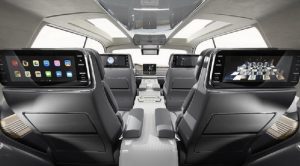
Both are also offered in even bigger – longer – versions, too.
But there is one huge difference between the two now.
It is that that the Lincoln comes standard with a V6 while the Cadillac still comes standard with a V8. Even so – and per the above – the Lincoln is the stronger of the two, both in terms of maximum horsepower and maximum towing capacity.
Prices – for the Navigator – start at $77,635 for the base RWD trim; adding the optional 4WD system bumps that up to $80,635. A bigger (longer) L version with more room for cargo behind the third row stickers for $80,630 to start. 
There are also Reserve and Black Label trims in standard and L versions – with prices topping out at $109,120 for a Black Label Reserve L with 4WD, 30-way power front seats with massagers and a 28 speaker premium audio system.
What’s New For 2023
No major changes for the new model year – which may be the last year before the Navigator gets a major makeover as the current model was last updated in 2018, five years ago. If you like the way the Navigator is, it is probably time to buy one before it becomes something else. The probability being something at least partially “electrified” – as in a plug-in hybrid layout – to keep the government happy and make you pay for it.
What’s good
Big – and bigger – sizes.
More power and towing capability than rivals.
Relatively affordable . . . relative to rivals.
What’s No So Good
Just one engine, regardless of trim (rival Escalade offers three different engines, including a diesel six and a supercharged V8).
Just one fill-up costs almost $100.
Like all of its rivals, the Navigator might be too big – for your garage.
Under The Hood
The Navigator’s standard 3.5 liter V6 is the strongest, smallest engine in this class. It makes 440 horsepower and 510 ft.-lbs. of torque. This outguns the Cadillac Escalade’s standard 6.2 liter V8, which is nearly twice the size, but only manages 420 horsepower and 460 ft.-lbs. of torque. This disparity probably accounts for the Lincoln’s higher – 8,700 lbs. towing capacity vs. the Cadillac’s lower 7,700 lb. maximum.
The V6 makes up for size with boost – times two. It has a pair of turbochargers bolted to it and these are responsible for its impressive output. Also for its relatively not-bad gas mileage, which is 17 city, 23 highway – which is very good for a massive (and massively heavy) super-sized SUV with a 440 horsepower ‘plant under its hood. It is also noticeably better mileage than the V8 Escalade’s 14 city, 19 highway.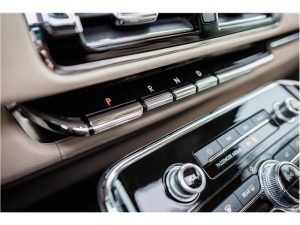
However, it still takes almost a C note (at current prices) to put 24 gallons gas in the Lincoln’s tank. That’s a lot to pay once a week – even for someone who can afford to make the monthly payments on a ride like this. The same, of course, is true of the Cadillac – and more so, because you’ll be filling its tank more often.
Also – and not insignificantly – the Lincoln’s V6 is a regular unleaded engine; the Caddy’s V8 prefers premium. For which you’ll pay a 30-50 cent premium for each gallon.
There is, however an asterisk – as regards the Escalade. You can select a turbo-diesel V6 in lieu of the V8 as a no-cost option and avoid paying for premium – and gas altogether. This engine is not as strong as the V8, but it does use a lot less fuel, to the tune of 21 city, 27 highway. Diesel does, however, cost more than gas – so your savings may be a wash, regardless.
The Caddy is also available with a supercharged version of the 6.2 liter V8 that makes 682 horsepower and 653 ft.-lbs. of torque. But this version of the big Caddy – the Escalade V – stickers for $149,195.
That’s nearly enough to buy two Navigators.
You can choose either rear-drive or (optionally) a full-time 4WD system; a ten speed automatic is standard regardless. Interestingly, it is the same ten speed automatic that you’d get in the Escalade. GM and Ford developed this transmission jointly. Its top three gears are all overdrive gears, each successfully reducing engine RPM such that at steady cruising speeds the engines in these bigs rigs are hardly idling. If these big rigs didn’t have all those overdrives, they’d be drinking.
Gas (and diesel) mileage would probably be single digits in the city and in the teens on the highway.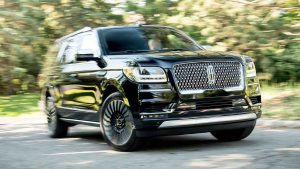
On The Road
Big SUVs and big trucks are the biggest sellers for a reason.
They’re big.
People like that. But they can’t get that in a car anymore – which is why cars aren’t selling anymore. Crossovers are bigger, but most lack the big engines – and big capabilities – that only big SUVs offer.
You can pull a Navigator with a Navigator. That is something beyond the capabilities of any crossover.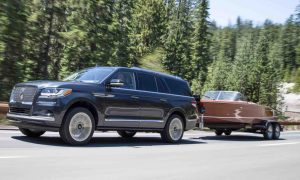
What’s most appealing, though – or at least, an additional appeal – is that as big as these rigs are, they are quieter and posher than cars. At least, modern cars – very few of which are rear-drive-based or have the body-on-frame construction the Navigator has – and which isolates the body from the frame and so the road. This is the way big American cars used to be built – and it is why such cars were big sellers, while they still were.
What you’re getting here, then, is essentially a big American car from the ’60s or ’70s – with all of the modern amenities. It may not seat three across in two rows, as the old bench seat boats did. But it seats more in its three rows. And – when equipped with 4WD – can handle snow far better than those rear-drive-only (and low-to-the-ground) dreadnoughts did.
But the driving experience is very similar. Just higher.
The steering is one-finger light and the powerful engine moves all that weight without apparent effort. The Cadillac’s V8 does sound better when roused – but the Lincoln’s V6 pulls harder, with much less apparent effort – as you’d expect given all 510 ft.-lbs. of torque is available come 3,000 RPM. The Caddy’s V8 must be spun up to 4,100 RPM before it makes maximum torque, of which there is also considerably less.
Being a passenger in a Navigator is also its own reward – especially if you weren’t a kid in the ’60s or ’70s and don’t have any memory of what it was like to be wafted off to sleep in the back seat of a luxury liner like this.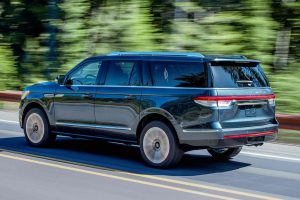
Lincoln does a better job on this score than Cadillac, too. The latter tries hard to be “sporty,” like the European makes. And it is. The ride is firmer, the steering sharper. But maybe you don’t want that. Maybe what you want is the opposite of that. Something that isn’t trying to be sporty – or flashy – that excels at being luxurious because that’s what the Navigator concentrates on – and excels at being.
But there is a downsize to the size of this thing.
hough it is not difficult to maneuver, there is often only so much room available to do so. Most on-street parking spaces are spaced for smaller vehicles and many garages at home won’t have much space left once you park a Navigator – or an Escalade – there.
If the standard 122.5 inch wheelbase Navigator isn’t quite big enough, there’s always the long wheelbase L (131.6 inches) version. Both versions have three rows of seats and room for seven. The main difference as regards the L is there’s even more room for whatever you need to carry beside people behind the third row.
The standard Navigator has 19.3 cubic feet of room behind its third row and that expands to a maximum volume of 103.3 cubic feet with the third and second row folded forward. In the L, you have 34.3 cubic feet behind the third row – almost twice as much room, so you’ll probably not need to fold the third row as often to make room. And if you need more room than that, the available room can be expanded to 120.2 cubic feet by folding the third and second rows.
Cadillac does offer the most room, however.
The long wheelbase (ESV) version of the Escalade has an astounding 41.5 cubic feet of room behind its third row and that opens up to 142.8 cubic feet with its second and third rows folded.
It’s a lot of room, either way – and that is one of the attractions of these big (and bigger) rigs.
The Lincoln’s look is softer than the Cadillac’s – outside and inside.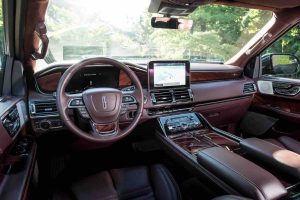
It is hard to find a sharp edge anywhere. They are everywhere on the Escalade. Not that there’s anything wrong with either look; in fact, it’s good to see some real differences, in spite of the general similarities. The Cadillac suggests bustle and urgency. The Lincoln, calmness. You pick the theme that appeals more to you – as well as the rest as those themes manifest in how these two SUVs feel and drive, too.
As Lincoln’s top-of-the-line model, the “base” trim includes almost everything – including a 14 speaker audio system, power folding running boards, adaptive headlights, adaptive suspension, heated and cooled leather seats, a 12-inch digital display instrument cluster and a 13.2 inch secondary touchscreen in the center stack. 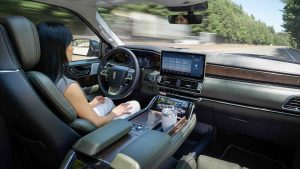
The Reserve adds 22 inch wheels, illuminated power-folding running boards, a panorama sunroof, upgraded (and 24 way adjustable) front seats and the option to buy a semi-self-driving feature Lincoln calls ActiveGlide (Cadillac offers a similar system with the Escalade). This latter automatically centers the Navigator in its travel lane and also maintains/adjusts speed and following distance in relation to the ebb and flow of traffic.
And if 24 way power seats aren’t quite sufficient, you can opt for 30 way seats that also have massagers built in and a 28 speaker ultra-premium audio system.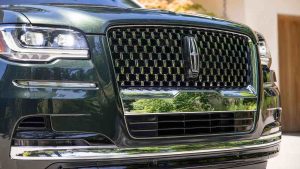
The Black Label adds services as well as amenities. In addition to a special 22-inch wheel package and “curated” (custom-picked) interior and exterior color palettes, you get complimentary car washes, an extended maintenance plan and a Digital Key that enables you to use a smartphone to unlock/start the vehicle and access some of the vehicle’s system remotely.
The Rest
As mentioned earlier, the current Navigator is basically the same as the 2018 Navigator, which is good – if you prefer things as they were as opposed to to where they are headed.
Soon – possibly as soon as the ’24 model year – the Navigator is likely to be something new. Which likely means at least partially “electrified” – i.e., partially hybridized. That is the way things are headed because there is increasingly no other way – shy of complete “electrification” – to comply with federal (and state, as in California) regulatory rigmarole regarding carbon dioxide “emissions” regulations.
This can have advantages – such as being able to drive for (typically) about 25 miles on electric/battery power – if it’s a plug-in hybrid. And gas mileage is usually higher, too. Sometimes, there’s more power – and higher performance as well.
But, that almost comes at a price. Adding what amounts to a second drivetrain typically adds thousands to the bottom line, greatly negating any fuel efficiency advantages of the hybrid layout. There is also the increase in parts and complexity – which increases the potential, at least, for more (and more expensive) problems, eventually. Of course that will not matter to those who lease and change up to a new ride every 3-4 years.
The Bottom Line
Big has proven to be better.
Or at least, very popular!
. . .
If you like what you’ve found here please consider supporting EPautos.
We depend on you to keep the wheels turning!
Our donate button is here.
If you prefer not to use PayPal, our mailing address is:
EPautos
721 Hummingbird Lane SE
Copper Hill, VA 24079
PS: Get an EPautos magnet or sticker or coaster in return for a $20 or more one-time donation or a $10 or more monthly recurring donation. (Please be sure to tell us you want a magnet or sticker or coaster – and also, provide an address, so we know where to mail the thing!)
My eBook about car buying (new and used) is also available for your favorite price – free! Click here. If that fails, email me at [email protected] and I will send you a copy directly!


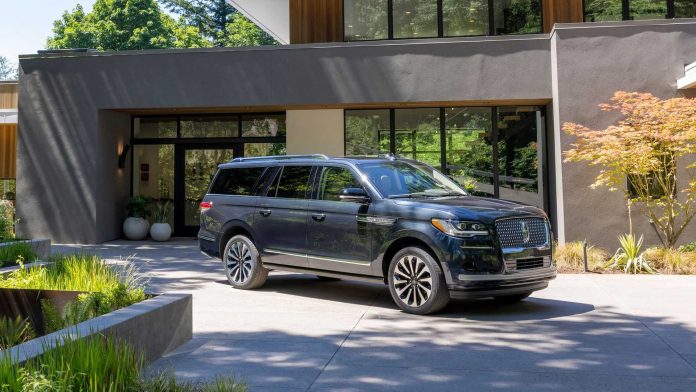


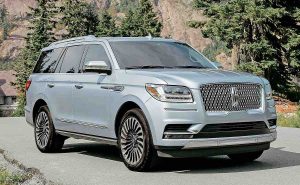







Ok, a 24-Way seat? I’m at a loss, I can think of 8-way seat positioning, tops, lol!
The Escalade and Navigator are getting too expensive for what they are. If I was going to spend six figures on a luxury SUV, I’d get a Range Rover. It’s a lot prettier and more luxurious than those hogs.
One thing I do miss which is lacking on the Navigator, and all cars/SUV’s these days, is a hood ornament sticking up to act as a sextant.
It’s okay not to have one on a sports-car cause you likely know where your fenders are and keeping it between the lines is a joy rather than the struggle it can be on taller & bigger vehicles, especially when you’re tired (like after a 14hr shift at work) or it’s snowing or raining so hard ya can barely see in front of you so you kind of drive by seeing the line on the right, or where the last set of tire tracks in the snow went through before you, or where you think the shoulder of the road is, or should be.
A hood ornament was a tool.
I imagine that when ‘they’ first did away with hood ornaments it resulted in many crashes & wrecks by people who used them & were used to them being there, especially as vehicles got taller & less easy to know where your front fenders were, ya kinda gotta guess, sometimes. Like when parking in tight spots, etc.
I have a ’16 Navigator L. I bought it used in ’17 with 11,000 miles. I’ve certified it to 2027 and 140,000 miles. I highly recommend the certification as the extra cost to certify it that long has long since paid off. I just had the Camshaft Phasers replaced, a 15 hour job, by the book, for $100.
That all being said, it’s quiet & comfortable, basically it drives like a large Town Car. I maneuvers relatively well, agile, for what it is and get’s reasonable gas mileage. And I’ve never had an issue finding parking, I’m in Texas and Super Duties and raised Trucks are all over. This is small compared to many of those.
Hi Bryan,
Roger that – especially about Texas. But, in my neck, parking one can be an issue because many parking spots are sized for modern cars. Put a current half-ton or similar in one and you may have trouble getting in and out of one, if there’s another one parked beside it!
But is there an armored version available? Like our beloved fuhrer gets driven around in?
I recently rented an Expedition (long version) because we needed a vehicle to handle six people and all their luggage for a couple days. It performed brilliantly, got excellent gas mileage, and was was plenty luxurious.
Lincolns are not Fords.
Park one somewhere in the vicinity of 8th and Massachusetts in Washington, DC just to see how long it would take for the Navigator to be gone. A tow truck will haul it, load it on the platform, drive away.
You can make some money with a tow truck to haul abandoned vehicles on roadways. Has to be done, can’t have abandoned vehicles strewn along the shoulders of highways and interstates. Just too dangerous.
The insurance company will have a claim filed and will investigate, call somebody who might know, then cut a check so you can buy something else.
You don’t want a Navigator. Period.
You have to be a Cadillac fanatic to buy one. You have to be a Lincoln nut to own one. Ford should drop the Lincoln shtick.
Revive Mercury, it’ll sell.
Just buy an Expedition, you’re good then.
At 80 grand, there is another less expensive vehicle with just as much and more appeal.
$109k – good god. Almost as much as my house cost 20 years ago.
Re: “Diesel does, however, cost more than gas – so your savings may be a wash, regardless.”
Which just irks me. For those that are younger or don’t remember, diesel was ALWAYs a lot cheaper than gas (for like 70 years), up until uncle sam got involved.
RE: “Wonder what the target demographic is”
Well, it won’t be me. Not at $81,000. I imagine that some people who would like to have a full sized pickup bed and still have more cargo space than behind a single cab bench seat might want one?
I took out the 3rd row seat on my 4×4 ’98 Navigator and it sure seems like I have a full sized pickup bed.
I can’t count the number of times I see guys struggling to fit 8’x2x4’s and other oversized items into short bed pickups or tiny SUV’s & often leaving half the load hanging over & out the end.
And, at least even with my ’98, this rings very true:
“What you’re getting here, then, is essentially a big American car from the ’60s or ’70s – with all of the modern amenities.”
I am so glad I picked up this ’98 just a few months before the used car market blasted off into high-price-space. Especially after reading this review of the ’23. Even IF it still costs as much to fill up as an $81,000 one does. I just drive it less.
‘Lincoln does a better job on this score than Cadillac, too. The former tries too hard to be “sporty,” like the European makes.’
Seems like ‘the latter’ was intended, referring to the Cadillac as trying too hard to be “sporty”?
The Navigator’s blocky design resembles cars I drew with crayons at age 6. Its tall, flat shovel nose just begs to be punched, though its 6,078-lb bulk would barely budge in response.
Wonder what the target demographic is for this supersized behemoth — supersized people?